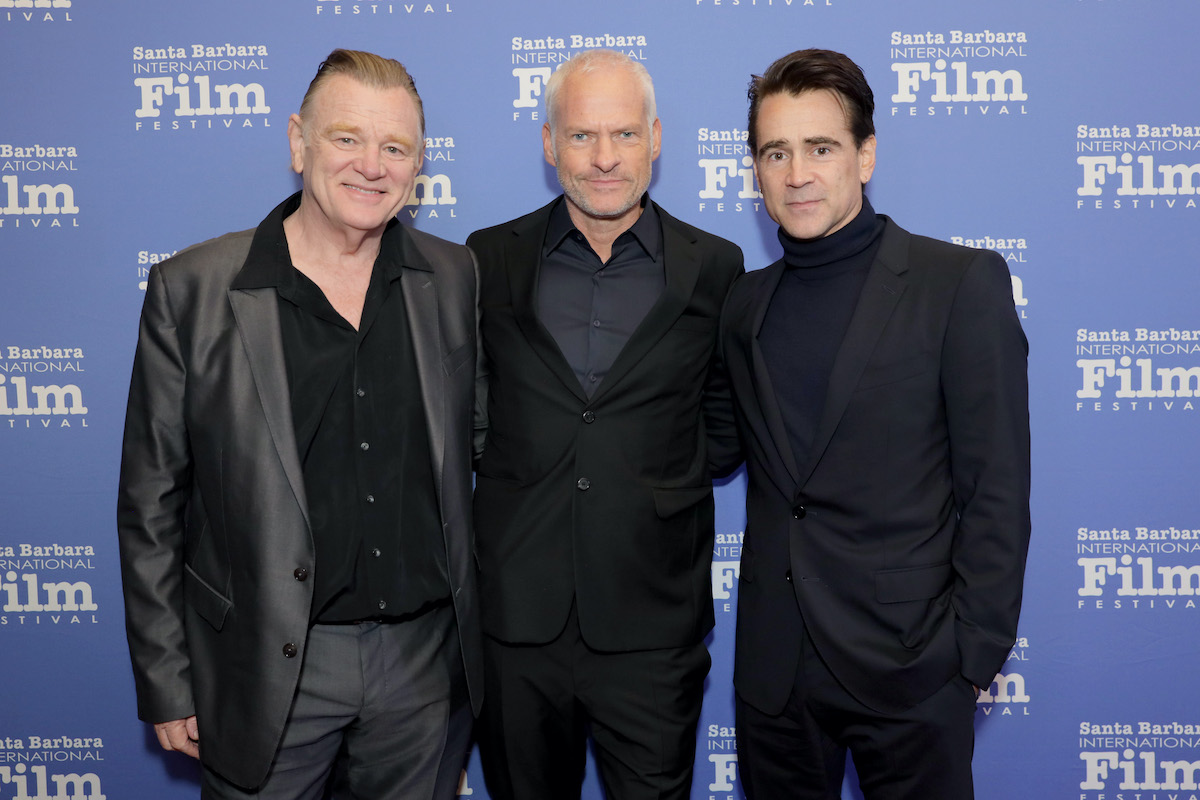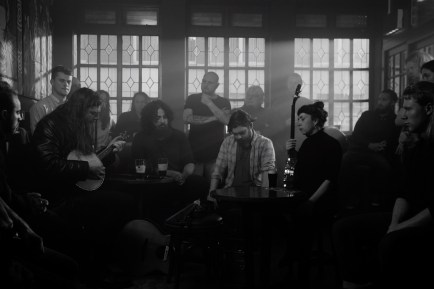Fine Feckin’ Friends with Colin Farrell and Brendan Gleeson
‘The Banshees of Inisherin’ Takes Over SBIFF's Cinema Vanguard Award
‘The Banshees of Inisherin’ Takes Over SBIFF's Cinema Vanguard Award

On the list of ironies cleverly tucked into The Banshees of Inisherin is a certain reel-versus-real-life paradox. With a deft, and gently absurdist — Beckett-ian, even — style, the film follows the story of two friends on a small Irish island who have fallen out with each other, although the film’s dynamic duo, Brendan Gleeson and Colin Farrell, share a unique and deep friendship in life off-screen.
That much was abundantly evident when the pair perched on the big white couch last night at the Arlington Theatre for the last of this year’s SBIFF actor tributes. (Tonight’s “Outstanding Directors” panel spotlights stars from behind the camera.)
References to Banshees, writer-director Martin McDonagh’s brilliant and imaginative film, started early and stayed late, understandably. The film has wowed critics and audiences, not to mention tickling Oscar buzzers. Asked by moderator Dave Karger (TCM) if he’s been taken aback by the whirlwind response and award-season hubbub, Farrell replied, “I have a pretty fecund imagination,” pausing and adding, with a grin, “That’s fecund, not fecking,” triggering much laughter in the full-ish house. Continuing, Farrell added, “But I couldn’t have imagined this would be happening, and that we would be in Santa Barbara.”
Banshees has the distinction of having the word “feckin’” more liberally littered throughout the script than any other film in history, so far as I know.
Farrell and Gleeson met some 17 years ago but cemented their mutual admiration alliance onscreen first in McDonagh’s raucous and fresh 2008 film In Bruges, of which Gleeson explained, “These characters are unlikely hit men, but they had to be believable as hit men.”
The evening spotlighted each actor’s filmography going back to early “breakout” films The General, with Gleeson as a real-life Irish gangster, and Tigerland, with Farrell as a soldier. On the recent release front, Gleeson nabbed an Emmy for his portrayal of Winston Churchill in TV’s Into the Storm, and Farrell donned radical makeup for his Marvel Universe gig as the Penguin in The Batman. Along the way, Farrell won points for daring in two films by the subversive Greek filmmaker Yorgos Lanthimos: The Lobster and The Killing of a Sacred Deer.
But the recurring centerpiece of the tribute was Banshees, in which Gleeson’s character, he said, “was in despair and possibly suicidal, obsessed with mortality and art, impending on him to an extreme. The relationship is lost because of the profundities of life he is pondering.”
Farrell’s character is often described as dull, but the actor says, “No human being can be dull. Everywhere, there has to be an archetype. We need to identify types. On an island, especially, everyone is a type. I thought he was very sweet and connected to nature.”
Carver asked about Jenny the donkey, a key character and sometime scene-stealer. “She’s put on a few,” joked Farrell. “She’s rock ‘n’ roll, man. But she’s one and done. ‘What’s this, six takes? Fuck that!’”
Presenting the festival’s Cinema Vanguard Award, McDonough exclaimed that “no other actors could have played these roles, because of their integrity, and because they’re totally feckin’ hilarious. We’re in this together, for good … if I could get off my ass and write something.”
SBIFF’s international programming component takes us places, almost literally. We’re able to experience other ways of being, cultural textures, and languages, and escape the noisy prospect of Hollywood’s screen presence. And some of these films from afar seize on the idea of creating portraits of place, with great specificity.

Director Luke McManus’s wondrous and artful documentary North Circular, given its North American premiere here, takes to a specific road — Dublin’s North Circular Road. In glorious, gorgeous black and white stock and a visual sensibility seemingly borrowed from still photography’s toolkit, McManus zooms in on sections and specific citizens along the road, with its mean street zones and echoes of history and impending gentrification, lined with affectionate portraits of its people along the way. Also lining the film, and the road, are liberal doses of indigenous Irish music, helping to tell the tale.
Across the ocean a bit, the Icelandic film Summerlight… and Then Comes the Night takes root in a humble, insular fishing village. Director Elfar Aðalsteins’s adaptation of the book by Jón Kalman Stefánsson skillfully cross-stitches subplots which are alternately tragic, comic, existential, and life-affirming, flecked with some of the dry, cool Icelandic humor we’ve come to know through past films from this global outpost, screened right here on State Street.
It has long been the case in SBIFFs programming scheme that the “Eastern bloc” films — from Eastern Europe and into the former Soviet zone — can be among the more intriguing and mold-busting items on the menu. They can also be on the darker, grittier side, and rough around the edges by comparison with glossy, formulaic Hollywood-colored production values.
Such is the case again this year. Whereas the French films, for instance — including the feel-good favorite The Nannies and Other People’s Children, both fine in their own ways — tend to be polished and equipped with predictable movie-making protocols, something deeper and more gripping takes charge in two of the festivals stronger titles, of Eastern European origin.

The Romanian film R.M.N., from writer-director Cristian Mungiu, weaves its gripping, thriller-tinged story from strands of subplots both personal and collective. The volatile antihero in the quivering center is ultimately just one part of the larger tale of xenophobic racism and vigilante violence in an economically strained Transylvanian village. Sri Lankan workers brought in to work in the local bakery are subjected to threats and possible expulsion, in a film where the last act is a cinematic stunner and riddle: An extended racism-fueled town meeting — shot in a single take — segues into to a sobering moment in the forest, and a night of potential dread follows. And yet we are not spoon-fed plot points or tidy conclusions.
Tidy narrative is also of little interest in the fascinating How Is Katia?, from Ukrainian director Christina Tynkevych. (Seeing a Ukrainian film made before the country’s war horrors of the past year adds an extra real-world layer of tension to the experience.) Slight spoiler alert: Katia is a young girl involved in a car accident that imperils her life and gradually sends her grieving mother into a state of altered reality.
In a sense, the film is an anatomy of a breakdown, creating a dizzy aura of sadness and suspended hope. In such a state, a conventionally made, easily deciphered filmic style might gloss over the pain of the lead. Instead, we burrow ever deeper into our protagonist’s state, with static shots and close-ups of her haunted face — which seems to age as it goes — and enigmatic scenes evoking unraveling, with hints of resolution in the margins. It’s a powerful and distinctively charactered film, the ambiguities of which deepen our connection to the subject.
Please note this login is to submit events or press releases. Use this page here to login for your Independent subscription
Not a member? Sign up here.
You must be logged in to post a comment.